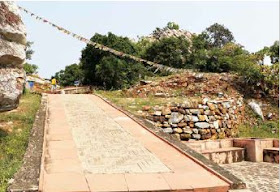Rajgir is one of the most important holy sites of Buddhism in India. Located amongst a green valley and rocky hills, the place is dotted with Archaeological Survey of India (ASI) protected sites that provide profound insight into the Buddha’s life and teaching. It is in this place that an important association with the teachings of the Buddha is found–the Vultures’ Peak–a small mountain at the outskirts of the ancient city of Rajgir.
It is believed that the Buddha had first delivered many of his important teachings and sutras (sermons) at Vultures’ Peak or Gridharkuta. As per legends, a cave at the site –Pipphali Cave–is said to earmark the place where the Buddha’s disciples had gathered for the very first time to discuss his teaching. Some of the collection of sutras that were said to have been discussed here includes Saddharmapundarika Sutra, the Surangama Samadhi Sutra, and Prajna-paramita Sutras.
As per another interesting legend, Mahakashyapa, one of the principal disciples of the Buddha, had recorded these teachings and placed them in custody of the naga people, to be released as and when mankind was ready to accept them. And rightly so, the beginning of the Mahayana literature was witnessed with the appearance of the Prajna Paramita Sutras between 200 B.C.E and 400 C.E. The Prajna Paramita literature has around 600 volumes, and the Heart Sutra is the condensation of the entire literature. Further, the Diamond Sutra is also attributed to the Prajna Paramita literature as well.
After reaching at the base of Vultures’ Peak, you could either choose to take a cable car and visit the Peace Pagoda built by Japanese Buddhists, on top of the Ratnagiri Hills, or walk to the top of a small peak where the Buddha is said to have actually preached.
If you decide to walk up the trail, you would pass many more spots associated with interesting legends about the place. One site claims to be a place where the Buddha was brought for treatment after his brother, driven by jealousy, tried to kill the Buddha with a boulder but managed to only smash his foot. While another earmarks a place where the Buddha and many senior monks visited to meditate, whenever they wanted to find a quiet place away from the village and the monastery.
As you keep climbing the steps towards the top, you will pass a large cave– Sukarakhata (the Boar’s Grotto). It is believed that the Buddha had delivered two of his discourses, the Discourse to Long Nails and the Sukarakhata Sutta, at this very place. It is also stated that Sariputta, one of two chief male disciples of the Buddha, had attained enlightenment here.
The peak is a range of low mountains, full of caves and cliffs. As you walk towards the holy caves, the path is lined-up with prayer flags, gold patches and candle stubs.
However, to reach the spot where as per the Mahayana tradition the Buddha had given the actual discourses, you need to walk a long way at a higher elevation. It is also legendary that the Buddha had also converted King Bimbisara, the then king of Magadha, to the new faith at this very place. King Bimbisara had said to have built a road leading to the top of the Vultures’ peak to listen to the Buddha’s discourses on a regular basis. A spot on the path marks the place where King Bimbisara had turned back his retinue, stating that it was not appropriate for him to visit the Buddha in his royal glory. Instead, the king decided to pay homage to the Buddha by taking the path on foot.
Although, reaching the top of the peak is a taxing climb, the associated views, legendary stories and green mountains surrounding the location make it a worthwhile effort. The space at the top is not a big one. You could find traces of a brick wall that encloses an altar at the centre, which has a statue of the Buddha. Once you reach the place, the profound serenity of the place engulfs your senses as you visualise the Enlightened One giving teachings, while monks and lay people listening to his words in apt silence. And, it is the same holy silence that fills your heart as you start your downward journey.
How to Reach
Airways: The nearest airport from the town of Rajgir is Gaya Airport, which his about 68 km southwest of the town. It is well-connected to Delhi, Kolkata and Varanasi. It is also connected to international destinations like Kathmandu, Colombo and Bangkok. The second nearest airport is Patna airport, about 98 northwest of the town. One may take taxis from both the airports to reach Rajgir.Railways: Rajgir railway station is almost at the centre of the town. Gaya railway station is the major railhead, which is about 60 km southwest of Rajgir. This station is connected with major cities in the state and other metros of the country.
Roadways: Several state-run and private buses connect Rajgir to Patna, Gaya, Nalanda and many other cities in the neighbouring region.
#Buddha #Buddhism #Zen #Life #Lifestyle #wisdomwinds


No comments:
Post a Comment